Keychain cubes and Silk PLA
Posted on: May 4th, 2024 3 minute read
Introduction
Hi everyone! Welcome to my first blog entry. Today I will be showcasing my 3d printed VEX keychains and their applications in various sorts of PLA plastic.
For some basic background: PLA is a kind of 3d printing plastic that is widely considered to be the easiest to print for beginners. It is safer than other kinds of plastics such as ABS because it releases fewer VOCs ( airborne particles ). Not to mention, it doesn't release Styrene which is a known carcinogen. For these prints, I use a Bambulab A1 printer, a mix of .2 and .4 mm nozzles, and a standard textured PEI plate.
Filaments
The 3 primary types of 3d printing filament I used for this project include PLA basic, PLA glow, and Silk PLA.Since PLA basic is... well... basic. I'll only be going over PLA Glow and Silk PLA.
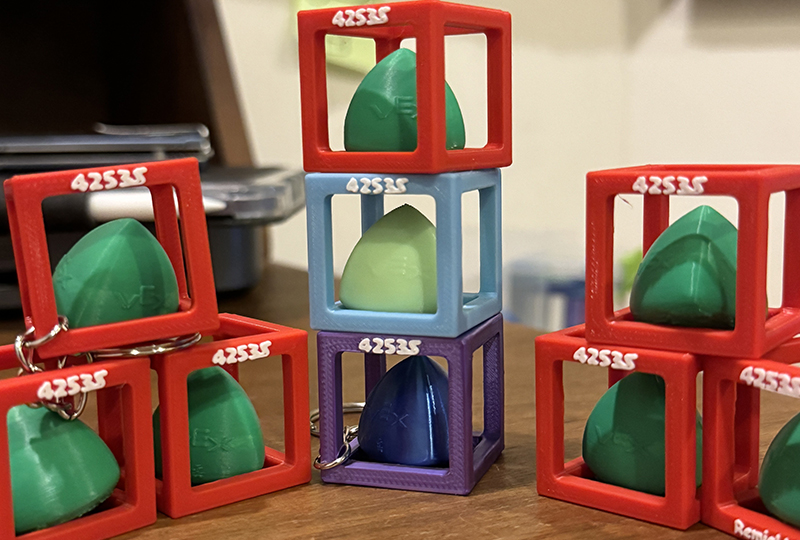
Silk PLA
Throughout the past month, I manufactured over 30 of these cubes, not including those that failed during printing. Printing failure occurred most often with Silk PLA, which is the least durable of the 3 and susceptible to breakage during printing. Although Silk PLA is appealing to look at, it is really stressful to print. In fact, the time it takes to print 1 cube made from Silk PLA is about the time you would take to print ~4 regular/glowing cubes. This is because Silk PLA tends to be printed at lower speeds. When the user lowers the print speed, the filament spends a greater amount of time in the hotend, consequentially drawing out the shining properties of Silk PLA. You can see that less shine occurs when it is rapidly heated by either increasing print speed or blasting it with a blowtorch. Pictured below is a side by side comparison of Silk PLA at different print speeds ranging from fast, medium, to slow.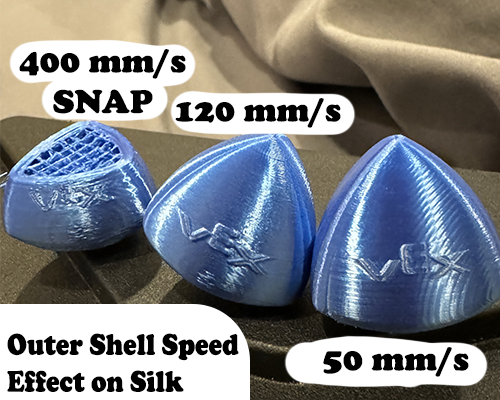
You can see a dramatic increase in gloss from the 120 millimeter per second print to the 50 millimeter per second print. This small change results in a 30 minute print time difference per triball. This may not seem like a lot initially but they do add up when printing in bulk.
This makes the Silk PLA vex cube unfeasible for large scale giveaways because they take much longer to make.
Moreover, the Silk PLA cubes are more fragile than the other 2 types of PLA. This is because the silk PLA is more brittle, making it more prone to breaking during printing and even after manufacturing.
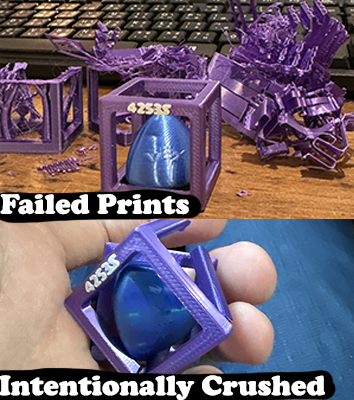 With only a moderate squish the silk PLA cube can be easily crushed. This is not the case with the other 2 types of PLA. PLA basic and PLA glow are much more durable and can withstand a lot more pressure. This makes them more ideal for keychains.
Nonetheless, Silk PLA does look amazing, which is my primary motivator for continuing to make Silk PLA cubes for special occasions.
With only a moderate squish the silk PLA cube can be easily crushed. This is not the case with the other 2 types of PLA. PLA basic and PLA glow are much more durable and can withstand a lot more pressure. This makes them more ideal for keychains.
Nonetheless, Silk PLA does look amazing, which is my primary motivator for continuing to make Silk PLA cubes for special occasions.
PLA Glow
PLA Glow was the filament type that I was most excited to use. In another project, I wanted to make stars to put on my cieling. So that I could look upon them when I sleep. I utilized 3 rolls of PLA glow from 2 different brands: Polymaker and Bambulab.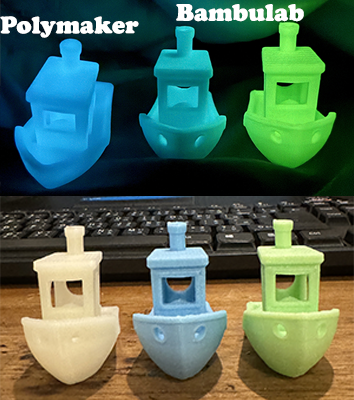 The glow in these images are exaggerated by long exposure photography on my iphone, normally it is a bit dimmer and the glow is only primarily visible in very dark conditions (under your bedsheets for example).
Glow in dark filament is almost as easy to print with as PLA basic, except for the fact that PLA Glow is only compatible with hardened nozzles. This is because PLA glow is abrasive, which, over time can wear out the hotend.
Unfortunately. I do not have a .2 hardened steel nozzle so the best I could do is print glow in dark filaments with a .4 mm nozzle.
Beyond this, I have yet to encounter any other problems with glow in dark filament and I'm pretty happy with it!
The glow in these images are exaggerated by long exposure photography on my iphone, normally it is a bit dimmer and the glow is only primarily visible in very dark conditions (under your bedsheets for example).
Glow in dark filament is almost as easy to print with as PLA basic, except for the fact that PLA Glow is only compatible with hardened nozzles. This is because PLA glow is abrasive, which, over time can wear out the hotend.
Unfortunately. I do not have a .2 hardened steel nozzle so the best I could do is print glow in dark filaments with a .4 mm nozzle.
Beyond this, I have yet to encounter any other problems with glow in dark filament and I'm pretty happy with it!
Manufacturing
A lot of you have asked me how I managed to get the triball into the cube. Well, there are several ways you could have approached this and the least wasteful method I found was to print the triball and cube separately, and then insert the triball in the middle of the cube's print.
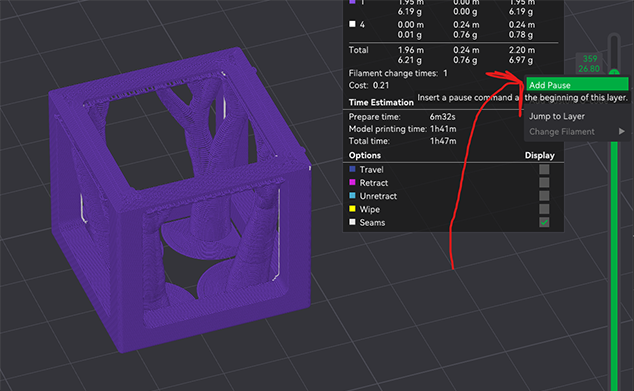 An easy way to do this is by pausing the print. Most slicers allow you to do this and Bambulab printers allow you to directly pause from the printer or your app. The slicer makes pausing easy and consistent.
Especially when you are away from home or are printing in bulk. For my design, the supports help grip onto the triball.
An easy way to do this is by pausing the print. Most slicers allow you to do this and Bambulab printers allow you to directly pause from the printer or your app. The slicer makes pausing easy and consistent.
Especially when you are away from home or are printing in bulk. For my design, the supports help grip onto the triball.
Now I still have a lot of these cubes, so if you still want some just hmu!!!